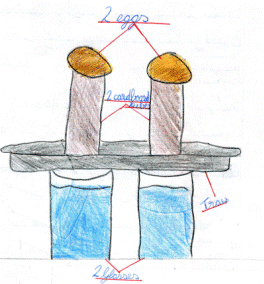Isaac Newton's Scientific Investigations 1. Newton's First Law of Motion (1) | 2. Newton's First Law of Motion (2) | 3. Newton's Third Law of Motion | 4. Newton's Colour Wheel 5. Balancing Butterfly | 6. The Floating Balloon
Newton's First Law of Motion (1) Experiment: "An object at rest (or in motion) stays at rest (or in motion) unless a force acts upon it."
Materials:
You will need: Method: What you have to do: 1) Fill your two glasses with water (to about three quarters full - important if you want to keep your eggs intact). 2) Balance the baking tray on top of the glasses. 3) Put your cardboard tubes directly above the glasses, but on the tray. 4) Place one egg (lime or orange) on top of each tube. 5) Give the tray a sharp tap. Result: The two eggs (limes or oranges) fell into the glasses of water.Conclusion: The eggs were at rest until the tubes were knocked out from under them and then gravity pulled them straight into the glasses. The baking tray was in motion until gravity acted upon it and pulled it down.
You can, of course, do the same experiment
with just one of each (egg, tube, glass) but it is more spectacular with
two. We have tried it successfully with three. Sixth | ||

